Choosing the Best Hard Drive for Synology NAS
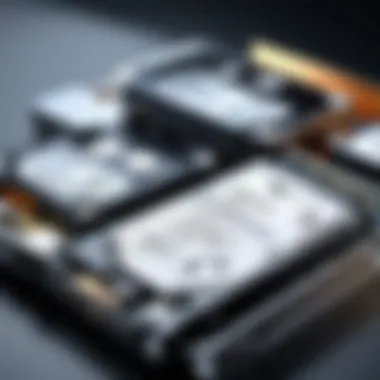
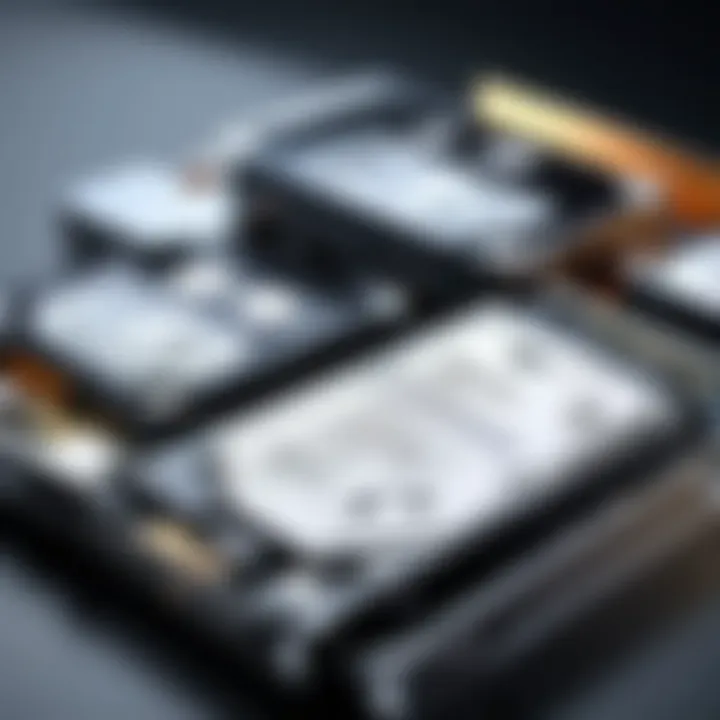
Overview of the Product
When considering a Synology NAS, the choice of hard drive plays a crucial role in shaping the overall experience. The market offers a plethora of options, but zeroing in on the right one can be a challenge. Synology NAS systems are notorious for their versatility and performance, but each model has its unique requirements and preferences. This section will outline the fundamental aspects of selecting a hard drive that complements your Synology environment effectively.
Purpose and Benefits
The primary purpose of selecting the right hard disk is to ensure optimum performance and reliability. A suitable hard drive can significantly influence data retrieval speeds, backup times, and even your ability to run applications directly from the NAS. A well-chosen drive boosts read and write speeds, facilitates smooth streaming for media, and enhances productivity for users who leverage their NAS for archiving important files. By investing time into research, you can avoid potential pitfalls and maximize the potential of your storage solution.
Target Audience
This guide is tailored for tech enthusiasts, gamers, and computer builders who aim to get the most out of their Synology NAS systems. Whether you’re a seasoned IT professional or a hobbyist looking to expand your home network's capabilities, the information provided here will help you make informed decisions. The content is designed to answer specific queries that arise during the hard drive selection process, helping you avoid headaches down the road.
Key Features
When exploring various hard drives, here are some features to keep a close eye on:
- Compatibility with the Synology model being used.
- Speed Ratings that indicate performance metrics such as RPM (Revolutions Per Minute) for HDDs.
- Storage Capacity that suits your needs, whether that’s terabytes for media storage or SSDs for speed.
- Durability Ratings, especially for clients that require drives to function without hitches in demanding scenarios.
- Warranty Periods, which speak to the manufacturer’s confidence in their product's longevity.
”Choosing a hard drive is more than just checking specs; it’s about understanding how those specs fit into your unique needs.”
Technical Specifications
Having a grasp on the technical specifications of hard drives can empower users to make smart choices. Below are key considerations that should not go overlooked.
Detailed Product Specs
Different hard drives showcase diverse specifications. Important numeric values include:
- Drive Type: HDD or SSD. HDDs are good for large capacity, while SSDs provide better speed.
- Interface: Commonly SATA, but NVMe models offer significantly faster data transfer.
- Form Factor: Typically 2.5-inch for SSDs and 3.5-inch for HDDs.
CPU Characteristics
While hard drives don’t inherently possess CPU capabilities, the performance of a NAS is impacted directly by the drive’s throughput. Some drives are optimized for high performance with SAS (Serial Attached SCSI) interfaces designed explicitly for enterprise solutions.
GPU Features
Similar to CPUs, GPUs don’t directly affect hard drives, but when files are being manipulated—like in rendering or video editing—ensuring a suitable hard drive can indirectly boost GPU performance while working with NAS.
Memory Details
Native memory in a hard drive relates closely to cache size. Drives with better cache (32MB or more) can handle temporary data more efficiently, crucial for speeding up repetitive tasks and small read/write operations.
Performance Benchmarks
It's beneficial to refer to benchmark tests available through tech forums or sites like Reddit. Results often compare data-transfer rates among various drives, shedding light on which performs best under specific loads.
Comparison with Similar Products
Market Competitors
The hard drive market is saturated with options. Brands like Western Digital, Seagate, and Samsung dominate the landscape with varying offerings like NAS-specific drives or more general-purpose models.
Comparative Analysis
When comparing, consider factors like:
- Speed: SSDs often lead in raw speed compared to HDDs.
- Price: Higher-speed options typically come at a premium.
- Energy Efficiency: SSDs are notably more power-saving than traditional HDDs.
Best Use Cases
Understanding your use case helps in selecting a drive. For example:
- Media Storage: Larger capacity HDDs may be ideal for massive media libraries.
- Fast Access Applications: SSDs would be favored for virtual machines or databases requiring rapid access.
Installation and Setup Guide
Requirements for Installation
To install your hard drive successfully, ensure you have:
- A compatible Synology NAS.
- Necessary tools like screwdrivers, as some models require physical access to the drive bays.
- Basic understanding of how hot-swapping works, should your NAS support it.
Step-by-Step Process
- Power off the NAS.
- Open the device’s chassis.
- Secure the drive in an available bay.
- Connect any required cables.
- Close the chassis and power the unit back on, following prompts for drive setup.
Tips for Optimizing Setup
Optimize your setup by formatting the drive correctly upon installation and considering RAID configurations for redundancies. These measures enhance data integrity and maximize performance.
Common Questionss and Troubleshooting
Common Issues and Solutions
Users might face the following:
- Drive Not Recognized: Check compatibility and ensure it’s seated correctly.
- Slow Performance: Assess if the NAS is overwhelmed with tasks or if the network connection is sluggish.
Expert Tips
Prioritize buying from retailers offering return policies, ensuring you can exchange if the drive doesn't meet your NAS’s expectations.
Understanding Synology NAS
When it comes to setting up a reliable storage solution, grasping the concept of a Synology Network Attached Storage (NAS) is essential. This knowledge isn’t just a technical nicety; it impacts everything from how you store data to how well you can access it. In this era where data flows like water, understanding NAS can often mean the difference between seamless workflow and a frustrating experience.
What is a NAS?
A Network Attached Storage system, or NAS, is a specialized device designed solely for providing access to data over a network. Think of it as your personal cloud solution but on your premises. Rather than storing files on local devices, a NAS allows multiple users and devices to access a central storage location. The beauty of a NAS is in its versatility: it can serve as a file server, facilitate data backups, host media content, and even run applications like web servers or databases.
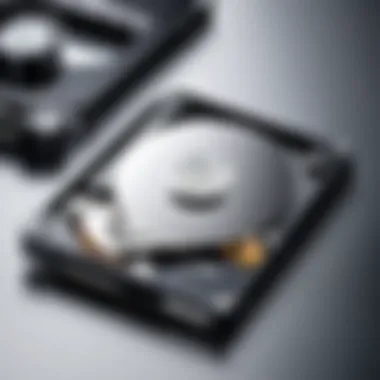
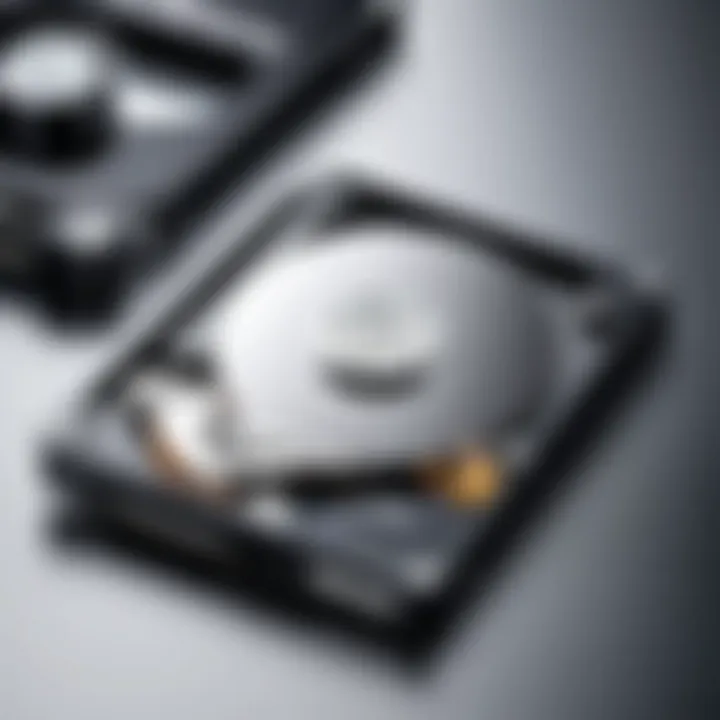
In simpler terms, if your home network is like a bustling city, the NAS acts as a central hub where all data can be accessed and shared. It typically includes one or multiple hard drives, managed through a dedicated operating system, offering features like user authentication, file encryption, and backup options. From a technical standpoint, this setup allows for greater flexibility and control over your data compared to traditional storage methods.
Key Features of Synology NAS
Synology NAS devices aren’t just run-of-the-mill storage units. They come packed with features that elevate them far above basic external drives. Here are some standout attributes:
- User-Friendly Interface: Synology’s DiskStation Manager (DSM) offers an intuitive web interface that makes file management a breeze. Users can easily set up shared folders, manage permissions, and monitor storage status without needing a PhD in networking.
- Versatile Backup Solutions: With built-in backup options, including the ability to schedule automatic backups or synchronize files across devices, Synology NAS ensures your data's safety without the tedious manual backup routine.
- Multi-User Accessibility: Different users can access designated files simultaneously without a hitch. This is particularly advantageous for teams and families who need to collaborate on shared files.
- Custom Applications: The Synology ecosystem supports a plethora of third-party applications, allowing users to expand functionality. Whether you're interested in multimedia playback, web hosting, or even surveillance solutions, there’s likely an app for that.
- Data Redundancy Options: Many Synology NAS setups support RAID configurations that provide redundancy, meaning that if one hard drive fails, your data is still safe on another. This quality is crucial for protecting important files from unexpected hardware issues.
Utilizing a Synology NAS transforms not just how you store and access data but also modernizes the workflow in any tech-driven environment. With such a system in place, users are ready to streamline their operations and increase both productivity and security across their digital assets. In short, the understanding of what a NAS is and its compelling features sets the groundwork for making informed decisions about your hard drive selection.
Importance of Choosing the Right HDD
Choosing the right hard drive for your Synology NAS is not just a mere task; it’s a pivotal step in ensuring that your entire storage system functions smoothly and effectively. With several options on the market, each boasting unique specifications and capabilities, the onus lies on the user to discern which one will serve their needs best.
A well-chosen HDD can enhance your Synology NAS performance, ensuring quick data access and storage reliability. On the flip side, selecting an ill-fitted drive can lead to bottlenecks, which can stall your workflow or even lead to potential data loss in severe cases. Thus, the criteria for choosing an HDD extend beyond just storage space; they encompass various operational efficiencies and usability aspects as well.
Key Elements of HDD Selection for Synology NAS
- Understanding Workload Requirements: Different users have distinct workloads. For instance, a gamer may demand faster read/write speeds for seamless gameplay, while a business might prioritize redundancy and consistency over speed. Knowing what you need is half the battle.
- Compatibility with NAS: Not all drives are designed for NAS systems, which can operate under different circumstances than standard desktop drives. It’s crucial to confirm that the HDD you choose can withstand 24/7 operation, particularly if you plan to utilize your NAS for extensive tasks such as file sharing or video editing.
- Performance Metrics: Performance is king when it comes to HDDs. Factors like RPM (Revolutions Per Minute) directly influence how quickly data is written and accessed. Higher RPM usually means better performance, but also a higher price tag. Balancing cost with performance is essential.
In short, understanding your needs and the specifics of various hard drives will empower you to make an informed decision that aligns with your own operational requirements.
Impact on Performance
When considering the impact on performance, think of an HDD as the lifeblood of your Synology NAS. It's responsible for how quickly you can retrieve and store data. A drive with a higher RPM, for example, accomplishes read/write tasks at a faster pace. The overall performance of your NAS can significantly hinge on this single component. If you’re in a position where load times make or break your efficiency, investing in a high-performance HDD is key. For heavy users, conventional hard drives may lag, while solid-state drives present a more agile solution.
Performance is not solely dictated by speed metrics; factors like caching and IOPS (Input/Output Operations Per Second) also come into play.
- Caching enhances data access times by storing commonly used information for quick retrieval.
- IOPS measures how many input/output operations can be conducted in a second, which can transform performance in a multi-user environment.
Reliability and Longevity
Reliability should weigh heavily on your decision-making process. Investing in a hard drive is akin to planting a tree; you want it to last and yield fruit over time.
Longevity in the context of hard drives is often estimated with terms like MTBF (Mean Time Between Failures). This metric acts as a predictive measure for drive failures, providing insight into the expected lifespan of your HDD. A drive with a higher MTBF score tends to be more reliable, which is crucial for data retention.
Moreover, RAID configurations can further extend the reliability of your storage setup. By distributing data across multiple drives, you can ensure that if one fails, your data isn't lost. This is especially relevant in business environments or for users who rely on their NAS for critical backup.
Types of Hard Drives Compatible with Synology NAS
When embarking on the journey of selecting the optimal hard drive for your Synology NAS, understanding the types of hard drives available is paramount. Different drives possess unique characteristics, which can significantly influence how your NAS performs. Whether you’re a tech enthusiast looking to optimize your setup or a casual user wanting reliable storage, knowing what’s out there is essential.
Traditional HDDs
Traditional Hard Disk Drives (HDDs) have been the stalwarts of data storage for decades. They utilize spinning disks to read and write data, making them well-suited for tasks that require ample storage space at a reasonable cost. Some notable benefits include:
- Affordability: HDDs generally provide larger storage capacities at lower prices compared to their counterparts.
- Capacity: High-capacity models can hold terabytes of data, which is especially useful for storing media libraries, backups, or archives.
However, it’s important to consider the downsides, such as lower read/write speeds compared to SSDs. They can become unwieldy in access-sensitive applications. So, while they offer great value for mass storage, they aren't always the best choice for speedy performance demands. Plus, traditional drives may be more susceptible to physical shocks and wear over time.
Solid-State Drives (SSDs)
Solid-State Drives have gained traction in the storage market for good reason. Unlike HDDs, SSDs use flash memory, which allows for significantly faster data access and a host of other advantages:
- Speed: SSDs can outperform traditional HDDs, providing quicker boot times and almost instantaneous file access. This is invaluable when speed is critical during tasks such as video editing and gaming.
- Durability: With no moving parts, SSDs tend to be less vulnerable to physical damage, making them a robust choice for portable setups.
But, here’s the catch—SSDs come at a premium cost, especially when looking for higher capacities. As a result, they might not be the best option if you’re primarily interested in large volumes of storage without breaking the bank. Nonetheless, when paired with a traditional HDD in a NAS setup, they can complement each other nicely, utilizing the strengths of each.
Hybrid Drives
Hybrid Drives, often termed SSHDs (Solid-State Hybrid Drives), strike a balance between the affordability of HDDs and the speed of SSDs. They combine the two technologies, featuring a traditional spinning disk along with a smaller portion of flash memory.
- Performance: By caching frequently accessed data on the flash memory, hybrid drives can provide improved read/write speeds without the higher costs of full SSDs.
- Value for Money: These drives offer a compelling option for users who want decent performance without sacrificing capacity.
However, while hybrid drives can indeed serve as a jack-of-all-trades, they’re also a master of none. There will always be limitations in speed compared to dedicated SSDs, and their pricing can still be a little tricky to navigate in relation to pure HDDs.
In summary, selecting the right type of hard drive will heavily depend on your use case and budget. With the landscape of storage technology constantly evolving, understanding the key attributes of the various options allows you to make informed decisions that align your storage needs with your performance expectations.
Key Specifications to Consider
When diving into the world of Synology NAS, understanding the right specifications for your hard drive can make a world of difference. These specifications are not just mere numbers; they play a crucial role in how effectively your NAS performs over time. Whether you're storing hefty game files, massive datasets, or simply backing up personal memories, getting the right hard drive will ensure you aren't left high and dry when you really need it.
Each hard drive comes with specific attributes that need careful consideration. This includes RPM, storage capacity, cache size, and MTBF along with warranty periods. These factors collectively determine how quickly your data can be accessed, how much data you can store, and how reliable your hard drive will be in the long run. Let’s dig deeper into these specifications to help you grasp their significance properly.
RPM and Speed
RPM, or revolutions per minute, is a fundamental metric used to measure the speed of a hard drive. Traditional HDDs can range from 5,400 to 7,200 RPM for average consumer drives, but performance-oriented ones can hit 10,000 RPM or even higher. The higher the RPM, the faster the read and write speeds, which means you'll experience better throughput when accessing or saving data.
For instance, if you're running a server that requires multiple users to access files simultaneously, a hard drive with a higher RPM is beneficial. On the flip side, if you're merely using a NAS for occasional media storage, a 5,400 RPM drive may suffice. Thus, consider your usage patterns before making a decision.
Storage Capacity
Storage capacity is often a point of contention among users. The choice here typically boils down to how much data you anticipate storing. Synology NAS models generally support various hard drive capacities, ranging from a few hundred gigabytes to several terabytes.
For example, if you plan to host a media server or manage large backups, opting for a 10TB drive might be prudent. Remember, however, that more storage often means higher costs. Make a realistic assessment of your current needs and anticipate future growth to choose a capacity that can accommodate your evolving storage requirements.
Cache Size
Next on the list is cache size. The cache acts like a buffer zone between the hard drive and the system. When you access files, the cache temporarily stores data to speed up future access. A larger cache size can significantly improve a drive's performance, particularly for repetitive data access patterns.
You often see cache sizes ranging from 16MB to 256MB in consumer drives. For a NAS system handling multiple simultaneous connections, investing in a hard drive with a substantial cache may yield noticeable improvements in file transfer times and overall responsiveness. Don’t underestimate the impact this can have on user experience!
MTBF and Warranty
Finally, let’s talk about MTBF, or Mean Time Between Failures, and warranty. MTBF represents the estimated lifespan of the drive under normal operating conditions. Drives with a higher MTBF usually indicate better durability and reliability.
Alongside MTBF, examining the warranty period can also offer insights into a drive’s reliability. Most manufacturers give a warranty ranging from 2 to 5 years, which often reflects their confidence in the product’s longevity. A longer warranty often correlates with higher-quality components inside the drive, ensuring you're protected against unforeseen failures. Always look at both metrics when making your purchase.
"Don't just look at the price tag; consider how long that investment will last. A bit more upfront can save you headaches down the line."
In summary, the key specifications for selecting the optimal hard drive for a Synology NAS are essential for your overall satisfaction and operational smoothness. Evaluating RPM and speed, storage capacity, cache size, along with MTBF and warranty, will empower you to make a sound investment, tailored to your specific needs. This careful evaluation today sets the stage for fulfilling user experiences tomorrow.
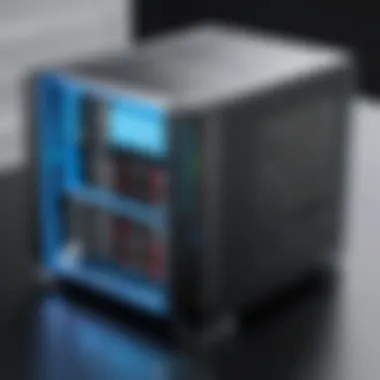
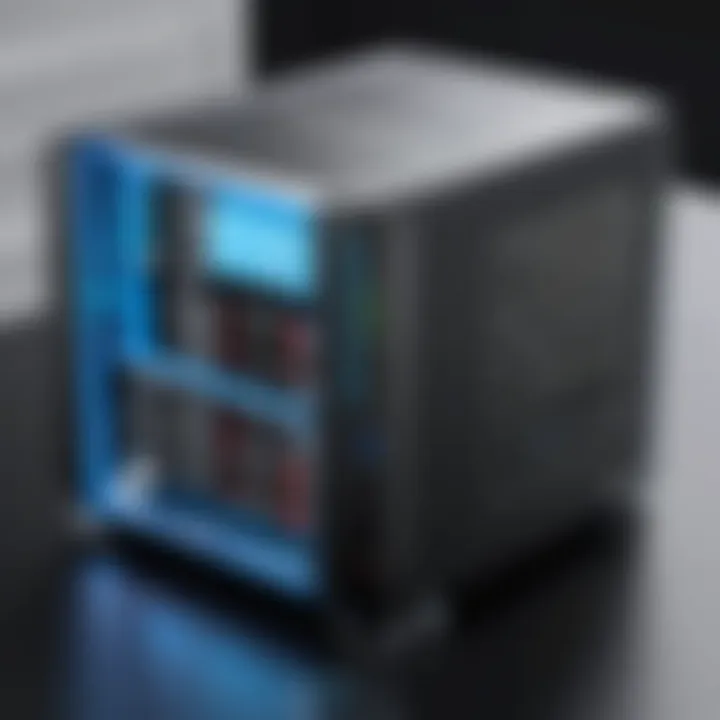
Top HDD Brands for Synology NAS
Selecting the right hard disk drive is crucial for the overall performance and reliability of your Synology Network Attached Storage. With various brands on the market, it can be challenging to determine which ones warrant your attention. Each brand brings its unique set of features, strengths, and reputation for reliability. By focusing on well-established brands, you can ensure that you are investing in a hard drive that meets the demands of your storage needs and ensures longevity.
When choosing a hard drive, it's essential to consider factors such as performance metrics, warranty offers, and customer support. A robust brand usually goes hand in hand with better quality control and might also provide good customer service in case of issues. In this section, we will delve into three prominent HDD brands: Western Digital, Seagate, and Toshiba. Let's examine what each one has to offer, helping you make an educated decision when selecting a drive for your Synology NAS.
Western Digital
Western Digital, often referred to as WD, has been a key player in the storage industry for decades. They are well-known for their Red series hard drives, which are specifically optimized for NAS environments. Red drives are engineered for 24/7 operation, boasting features like enhanced error correction and lower power consumption that ensure sustained performance under load.
One significant aspect of WD drives is their reliability. Users have reported that the WD Red drives can outperform many competitors in terms of MTBF (Mean Time Between Failures). The warranty options for these drives also tend to be generous, offering 3-5 years depending on the model.
If your priority is a quiet, efficient, and reliable drive tailored for NAS, Western Digital's offerings might just hit the mark.
Seagate
Seagate is another heavyweight in the data storage game, recognized for its expansive range of HDDs and SSDs. They have the IronWolf series, which is designed explicitly for NAS usage, boasting high resilience and optimized performance under multitasking environments.
The standout feature of Seagate's IronWolf drives is its AgileArray technology, which optimizes the drives for RAID configurations. This is crucial for users deploying RAID setups in their Synology, as it enhances data integrity, performance, and system responsiveness. Seagate also frequently issues firmware updates that can improve performance and address potential issues.
Moreover, Seagate typically offers competitive pricing compared to other brands, making them an attractive option for budget-conscious buyers. Their Bass rock-solid customer service further backs up the brand’s credibility.
Toshiba
While Toshiba might not have the same overwhelming market presence as Western Digital or Seagate, it still holds its own in the NAS space. Their N300 series is engineered specifically for NAS systems and supports a robust environment, featuring high reliability and performance metrics.
Toshiba drives are known for their efficient thermal control, helping maintain operational integrity even under sustained load. One specific advantage of Toshiba drives is the fact they often come with a shorter latency, which can improve the overall responsiveness of your NAS.
In terms of pricing, Toshiba tends to position itself as a cost-effective solution without skimping on quality. For those who are looking for a balance between performance and price, Toshiba's N300 series is worth considering.
Conclusion: Each brand brings its own strengths to the table. Western Digital leads with reliability and NAS-specific features, Seagate excels in performance with advanced technology, and Toshiba offers a budget-friendly yet effective solution. The key is identifying which brand aligns best with your specific performance goals and budget constraints. By focusing on these top brands, you're setting up your Synology NAS for success.
Evaluating Hard Drive Performance
When it comes to setting up your Synology NAS, evaluating hard drive performance becomes a cornerstone of the buying decision. Selecting the right hard drive isn't just about grabbing the first one off the shelf; it's about understanding how the specific performance metrics relate to the tasks you'll be performing. A NAS is often employed to handle demanding applications—whether it's media streaming, data backup, or virtualization—so ensuring that your hard drives can predictably perform under load is essential.
Read and Write Speeds
Read and write speeds are the lifeblood of your hard drive's performance. Simply put, read speed gauges how quickly your data can be accessed, while write speed reflects how fast you can store data. For those who plan to handle large files—like 4K videos or hefty databases—these metrics take on a whole new level of importance.
For example, a typical hard drive may advertise a read speed of 200 MB/s. However, during real-world use, various factors like file fragmentation or a busy NAS environment may lead to lower effective speeds. Thus, it's wise to look for drives that perform consistently.
"In the realm of NAS systems, speed can often be a decisive factor between smooth operation and frustrating delays."
Also, it's good practice to understand the distinction between sequential and random read and write speeds. Sequential speeds relate to large contiguous blocks of data, which is common with during backup operations. On the other hand, random speeds matter when small files are accessed, which often characterizes everyday usage.
IOPS and Latency
Another critical performance metric for any hard drive is IOPS, or Input/Output Operations Per Second. This metric gives insight into how many operations your drive can perform in a given second. If you're running multiple tasks—like serving files to several users or running virtual machines—higher IOPS can significantly improve responsiveness and throughput.
Latency, often intertwined with IOPS, refers to the delay before a transfer of data begins following an instruction. A hard drive with low latency means it can quickly start working on commands, leading to a faster overall experience.
When evaluating IOPS and latency, consider the following points:
- Application Usage: If tasks require many small read/write operations, IOPS becomes paramount.
- Drive Type: SSDs inherently have better IOPS and lower latency compared to traditional HDDs; hence, they shine in demanding workloads.
- Benchmark Testing: Look into benchmark results from third-party websites to get an realistic picture of performance under various conditions.
In summary, knowing how to evaluate hard drive performance can save you from buyer's remorse down the line. When you couple read/write speeds with IOPS and latency considerations, you've got a solid groundwork for selecting a hard drive that will serve your Synology NAS effectively. This fundamental understanding empowers you to make a choice that not just fits your current needs but positions you well for future demands.
Installation Considerations
When choosing a hard drive for your Synology NAS, it's crucial to take into account the various installation considerations. These aren’t just details to overlook; they can directly affect the performance, longevity, and overall efficiency of your storage solutions. Proper installation ensures that the hardware operates smoothly amidst the unique demands placed on it during regular use.
By focusing on installation considerations, you're setting the groundwork for an effective data storage and retrieval process. Recognizing the need to facilitate a seamless integration of the hard drive with your existing NAS will make your experience significantly better. In this section, we’ll explore key aspects, from the physical installation process to ensuring compatibility with existing hardware.
Physical Installation Process
Getting your hard drive physically set up can seem straightforward, but a few key steps can make a big difference in ensuring that everything functions as it should. First, ensure you have the right tools at hand. You’ll likely need a screwdriver, and having an anti-static wrist strap is a good idea to prevent any static damage.
- Power Down: Always, and I mean always, turn off and unplug your Synology NAS before beginning any installation. You wouldn’t want to fry your components!
- Open the NAS Enclosure: Remove the cover or lid of your NAS. This is usually done by unscrewing a few screws or sliding off a panel, depending on your device model.
- Locate Drive Bays: Identify where the hard drives are installed. Most NAS devices will have dedicated slots for hard drives that can easily be accessed.
- Connect the Hard Drive: Once you've got the slot, gently slide the hard drive into position, ensuring that the connectors align correctly with the NAS ports.
- Secure the Drive: Use screws or latch mechanisms provided by the NAS to secure the hard drive in place.
- Close the NAS: Put the case back together securely.
- Power Up: Finally, plug your NAS back in and power it on.
Taking your time during this step is critical; rushing might lead to misalignment or faults. Ensure every connection is solid before you wrap it up.
Compatibility with Existing Hardware
The next vital piece of the puzzle revolves around compatibility. Even if you have the best hard drive on the market, if it doesn't play nice with your existing hardware, you're going to have a rocky experience.
- Check Specifications: Before purchasing a hard drive, confirm that its specifications align with your Synology NAS model. Look at size, connector type (SATA, SAS), and interface speed.
- Firmware Upgrades: Keeping your NAS firmware updated can help a lot. Many times, compatibility hinges on software updates that enhance collaborative performance between different hardware.
- Capacity Constraints: Your NAS has limits on how much storage it can handle based on the model. Make sure you’re not overshooting that limit.
- Mixing Drives: If you’re planning on adding multiple drives, consider that not all drives work well together. Mixing different brands or generations of drives might lead to performance drops.
By prioritizing compatibility, you're not just throwing a drive into the device and hoping for the best. Instead, you're ensuring a conducive environment for your hard drives to thrive, which often translates into fewer headaches down the road.
"Ensuring that your hardware all plays well together is just as important as selecting high-quality components."
Managing Storage with Synology NAS
Managing storage effectively within a Synology NAS is a critical stride towards ensuring your data remains accessible, secure, and well-organized. The intricate connection between storage organization and overall performance is often overlooked. However, understanding how to properly manage storage not only enhances performance but also contributes to longevity and reliability. This segment dives into the nuances of managing storage, particularly the importance of setting up storage pools and understanding RAID configurations.
Setting Up Storage Pools
Setting up storage pools is one of the first steps you take when configuring your Synology NAS. A storage pool is basically a collection of hard drives organized to provide redundancy, performance, and ease of management. Think of it as assembling a team of players that work together to achieve a common goal: in this case, serving up your data!
To set up a storage pool, you'll need to decide on a few key aspects:
- Capacity Requirements: Assess how much data you plan to store right now and in the foreseeable future. Overestimating can lead to wasted space, while underestimating can create headaches down the line.
- Drive Configuration: Pick matching drives if possible, similar in size and speed. Disparate drives can complicate issues such as performance and backup strategies.
- Redundancy Needs: Choosing the right RAID level is important here. Different RAID configurations provide varying levels of fault tolerance, so if one disk bites the dust, you can recover your data without a hitch.
Once you have these aspects figured out, constructing the storage pool is straightforward through the Synology DiskStation Manager (DSM) interface. This interface guides you seamlessly through the steps required, making what could be a challenging task relatively easy. It’s clever, really, and takes a load off your back.
RAID Configurations Explained
Now onto a topic that can often feel like trying to solve a Rubik's Cube blindfolded: RAID configurations. RAID stands for Redundant Array of Independent Disks, and it’s vital for improving both performance and redundancy in your NAS setup. Here’s a quick rundown to demystify things a bit:
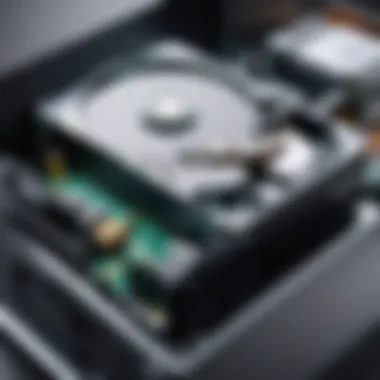
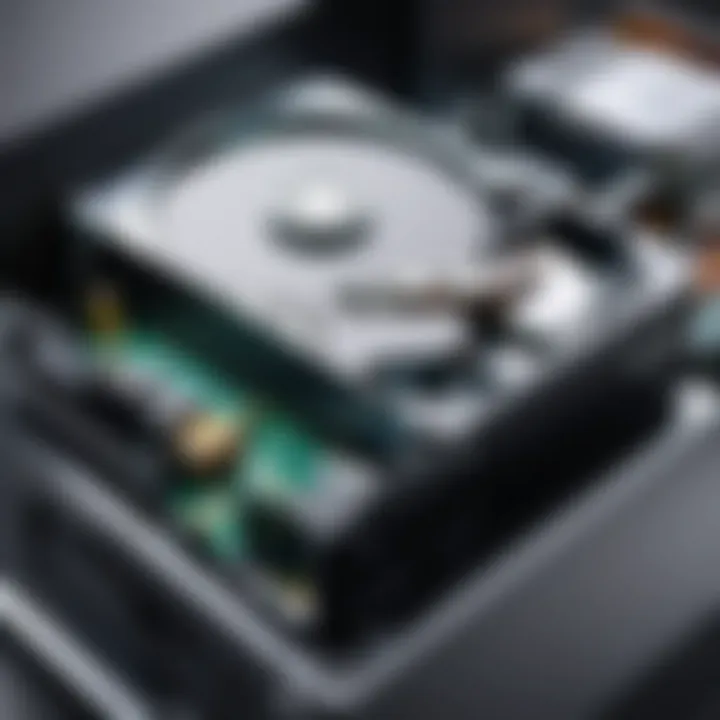
- RAID 0: This setup divides data across multiple drives to increase speed. It looks great on paper, but if one drive fails, the whole lot goes down with it. It’s risky business.
- RAID 1: This mirrors data across two drives. If one fails, you still have the exact copy on the other. It’s a fail-safe method that sacrifices capacity for security, keeping your data well-protected.
- RAID 5: This combines striping with parity data, allowing for one drive to fail without data loss. It provides a good balance between performance and resilience, making it popular among users.
- RAID 6: Similar to RAID 5 but with two parity blocks, it can survive two disk failures. For those who can’t afford to lose any data at all, this might be the way to go.
- RAID 10: This blends RAID 0 and RAID 1, requiring a minimum of four drives. It's great for both speed and redundancy. You get the best of both worlds, but it can come with a hefty price tag.
With each configuration, the pros and cons vary significantly. So it’s imperative to consider what matters most for your specific scenario—speed, capacity, or data protection.
Remember, effective management of your storage not only enhances the efficiency of your Synology NAS but also establishes a solid foundation for your future storage needs. Properly configured storage pools and thoughtful RAID decisions will save you headaches and heartaches down the line.
Maintenance and Monitoring of HDDs
Keeping your hard drives in top shape is as vital as picking the right one in the first place. Without proper maintenance and monitoring, even the best hardware can falter, leading to unsatisfactory performance or, worse, data loss. For users owning a Synology NAS, the stakes are high— that storage device serves as a central repository for critical files, backups, and perhaps even moments captured via videos or photographs. Let’s dive into the nitty-gritty of why maintenance and monitoring should be at the forefront of your Synology experience.
Regular Health Checks
Regular health checks serve as a backbone for your hard drive's longevity. Think of it as taking your car for routine servicing. Just like that vehicle needs oil changes and tire rotations to run smoothly, your hard drive requires periodic assessments to ensure everything is in working order.
A common practice is to employ SMART (Self-Monitoring, Analysis, and Reporting Technology) tests on your drives. SMART is like a built-in mechanic for your HDD. It tracks various parameters, including temperature and read/write errors, to predict potential failures before they occur. Running this test every few months can save you a lot of headaches down the road. If you spot an anomaly—say, unusual vibrations or clicking noises—this can indicate that something isn't right. The earlier these signs are caught, the easier and less costly it can be to mitigate.
"An ounce of prevention is worth a pound of cure."
This cliche rings particularly true when it comes to hard drives.
Firmware Updates
In today’s tech landscape, neglecting firmware updates can be like flying a plane without checking the instruments. Just as those guidance systems ensure a safe flight, firmware updates keep your hard drives running optimally, patching bugs, and adding vital features.
Typically, manufacturers release firmware updates to address any identified vulnerabilities or improve compatibility. While newer drives might come with the latest updates right out of the box, it’s essential to regularly check for updates after installation. Not only does this improve functionality, but it can also enhance the lifespan of the drive.
To ensure you're not flying blind with outdated firmware, visit the manufacturer's website and follow their guidelines on updating. This process is usually simple, often taking just a few minutes and a handy USB stick. With every firmware update, you strengthen the security and performance of your Synology NAS, thereby safeguarding essential data.
Cost Considerations
When it comes to choosing the right hard drive for your Synology NAS, cost considerations play a critical role in the decision-making process. It’s not just about how much you spend on the drives; it’s about understanding what those costs mean for the overall efficiency and longevity of your storage solution. With a myriad of options available, from budget-friendly traditional HDDs to higher-end SSDs, it becomes paramount to assess your financial capacity against your performance needs.
Being mindful of your budget can prevent overspending on unnecessary features while ensuring you acquire a drive that meets or exceeds your requirements. A thorough approach to budgeting often reveals hidden costs that may otherwise be overlooked, such as potential replacements or upgrades down the line. Remember, a more expensive drive could save you money in maintenance if it lasts longer and performs better.
Budgeting for Storage Solutions
Budgeting for storage solutions for your Synology NAS requires a deliberate eye on both current and future needs. Begin by evaluating the amount of data you intend to store and the performance level required for your applications.
Here are a few considerations:
- Assess Your Needs: Determine how much storage you require today and forecast for the future. If you plan to add more data later, consider investing in larger-capacity drives now instead of just tacking on smaller ones.
- Cost of Ownership: Factor in not just the purchase price of the hard drive, but also the long-term costs. Drives that offer better warranties or durability might have a higher upfront cost but could save you in the long run by reducing failures.
- Sales and Discounts: Keep an eye out for sales or bundle deals. The technology market can be notoriously unpredictable, and a wait for a promotional period might yield a better price on high-quality drives.
In tackling these aspects, having a clear picture of your budget enables you to more strategically choose drives that align with your current and future storage needs without straining your finances.
Cost versus Performance Analysis
When weighing cost against performance, finding that ideal balance becomes crucial. You want to ensure your investment pays off, and to do this, consider the specifications that matter most for your intended use.
- Performance Metrics: Drives with higher RPMs or SSDs with faster read/write speeds often come with higher price tags. Yet, for users with intensive workloads—like gamers or video editors—these enhancements can translate to time saved and improved user experiences. Is it really worth pinching pennies when a quicker drive could shave off hours of processing?
- Long-Term Investment: Sometimes it’s wiser to invest a little more today rather than face significant costs later due to premature failures or the need to repeat purchases. Drives designed for NAS situations might be pricier but often feature more robust construction, better heat management, and longer product lifespans.
- Comparative Analysis: Do the math. Compare different models not only on purchase price but also on their anticipated lifespan, warranty offerings, and historical performance. Online communities like reddit.com can provide shared experiences that aid in understanding long-term value.
Potential Issues and Troubleshooting
When it comes to setting up and maintaining a Synology NAS, it’s crucial to be aware of the potential issues that might crop up with hard drives. After all, a hard drive is a key component, directly influencing how well your NAS performs. Ignoring these problems can lead to unexpected downtime and data loss. This section explores the common pitfalls and how to tackle them effectively.
Common Hard Drive Failures
It’s a tough pill to swallow, but hard drives do fail every now and then. From sudden power outages to the wear and tear of mechanical parts, various reasons can bring a drive to its knees. Here are some frequent issues to keep an eye out for:
- Mechanical Failure: Typically indicative of a physical malfunction within the reading/writing mechanisms of traditional HDDs, it can result from excessive use or bad sectors developing over time.
- Firmware Corruption: Occasionally, the firmware can take a hit due to system interruptions or improper updates. This can render the drive unresponsive, leaving you in a bind until a proper firmware restoration is performed.
- Temperature Extremes: Hard drives are sensitive to temperature. Overheating can warp components and lead to failure while extreme cold might cause parts to contract, leading to mechanical stress.
- Bad Sectors: Some areas of the hard drive may become unreadable due to physical damage. These bad sectors can proliferate, making it harder for the drive to function efficiently.
Identifying signs of failure early can save a lot of heartburn later on. Keep an ear out for unusual noises and check for performance dips. Regular monitoring is key.
Data Recovery Options
Now, should the unthinkable happen and your data goes belly up, it’s important to understand the recovery avenues available. Not all hope is lost just because a hard drive fails! Here’s what you can do:
- Backup Recovery: If you’ve been diligent with your backups (which you should be!), restoring data from a backup can be seamless. This underscores the importance of a solid backup strategy.
- Software Solutions: Numerous data recovery tools exist that can help retrieve lost data, especially in cases of logical failure. Tools like Recuva or EaseUS Data Recovery Wizard can be invaluable if your data loss is not hardware-related.
- Professional Services: If the data is absolutely critical and you’re not getting anywhere, you might want to bite the bullet and call in the professionals. Data recovery services can dissect a failed drive and pull out precious files for a fee. While it can be on the pricey side, it might be worth every penny for pivotal data.
- RAID Configurations: If your NAS setup includes RAID, it can minimize data loss during a hard drive failure. Some RAID configurations allow for redundancy, which provides a layer of protection against data loss. However, it is not a replacement for regular backups.
Always prioritize regular backups. Protecting your data should be as routine as brushing your teeth.
Future Trends in NAS Storage
As technology progresses, the landscape of Network Attached Storage (NAS) systems continues to evolve, presenting exciting opportunities and considerations for users. Understanding these future trends in NAS storage is crucial because they not only shape consumer buying decisions but also influence system performance and longevity. With growing amounts of data to store and speed demands increasing across various industries, it's essential for tech enthusiasts and everyday consumers alike to stay informed about these changes.
Advancements in HDD Technology
The hard disk drive industry is navigating a transformative phase, ushering in technologies that aim to push the envelope in terms of capacity, speed, and energy efficiency. For instance, the use of shingled magnetic recording (SMR) is expanding, allowing HDDs to achieve larger capacities without major price hikes. This is particularly beneficial for NAS users looking to maximize storage while managing costs.
Moreover, manufacturers are striving toward reducing the physical footprint of hard drives while simultaneously enhancing their performance metrics. Drives that utilize helicopter technology are on the rise, which enables faster data access speeds. The integration of artificial intelligence into drive management systems aids in optimizing performance and predictably managing power consumption. These advancements mean that users can expect HDDs that are not only robust but also perfectly aligned with modern digital demands.
The Rise of SSDs in NAS Environments
Gone are the days when solid-state drives were merely a luxury reserved for high-end desktops or laptops. A noticeable trend is that SSDs are increasingly being embraced in NAS environments, primarily due to their superior performance metrics like faster read/write speeds and lower latencies. This shift comes with a myriad of benefits:
- Performance: With their remarkable speed capabilities, SSDs provide quicker data access, which can significantly enhance the user’s experience by reducing loading times for applications and files.
- Durability: Solid-state drives have no moving parts, making them more resilient to shocks and drops, which is often a concern in a dynamic home or small office environment.
- Energy Efficiency: SSDs consume less power than their HDD counterparts. This energy efficiency can lead to cost savings in terms of electricity bills for users who keep their NAS systems running around the clock.
However, it’s crucial to consider the potential challenges that come with SSDs, such as higher costs per gigabyte compared to traditional HDDs. This means that NAS users will need to weigh their performance needs against budget realities carefully.
Understanding these future trends aids users in making strategic decisions aligned with both immediate and long-term storage needs, ensuring optimal function and durability. Readers should feel equipped to not only select drives that serve current purposes but are also future-proofed for what lies ahead.
Closure
In the world of Network Attached Storage (NAS), the selection of the right hard drive is pivotal, especially for a well-regarded brand like Synology. A suitable hard drive can not only enhance your NAS performance but also ensure data integrity and longevity. The considerations surrounding hard drive selection cannot be overstated; from understanding the technical specifications to evaluating performance metrics, each factor deserves attention.
Summarizing Key Insights
Firstly, we explored the various types of hard drives compatible with Synology NAS, namely Traditional HDDs, SSDs, and Hybrid Drives. Each type possesses unique characteristics that make them suitable for different use cases. Traditional HDDs generally offer larger capacities at a lower price point, but may not match SSDs in speed. On the other hand, SSDs deliver exceptional speed but can come with a hefty price tag. Hybrid drives try to strike a balance, yet an understanding of personal storage needs will guide a better choice.
Performance metrics, including RPM, read/write speeds, and IOPS, emerged as crucial factors to monitor. These specifications directly impact the responsiveness of the system. Furthermore, familiarity with rival brands like Western Digital, Seagate, and Toshiba helped underscore quality and reliability, providing readers with a list of trusted choices.
Beyond specifications, the management of storage through proper setup of storage pools and RAID configurations greatly affects functionality in the long run. Regular maintenance and health checks can prevent issues before they become catastrophic, ensuring uninterrupted access to vital data.
Final Thoughts on HDD Selection
When approaching the selection process for your NAS hard drive, bear in mind that it’s not a one-size-fits-all journey. Budget constraints, performance requirements, and future scalability all play significant roles in deciding the best drive for your Synology system.
Understanding your own goals—whether you're a tech enthusiast looking to store vast media libraries, or a gamer wanting low-latency data access—will guide you to make a well-informed decision. Ultimately, achieving the perfect balance between budget and performance depends on thorough research, careful consideration of current market trends, and a crisp understanding of your usage needs.
Remember, investing in the right hard drive today lays the foundation for a robust storage solution tomorrow. The right choice can potentially double the productivity and efficiency of your NAS, transforming it from a simple data repository to a powerful data hub.



